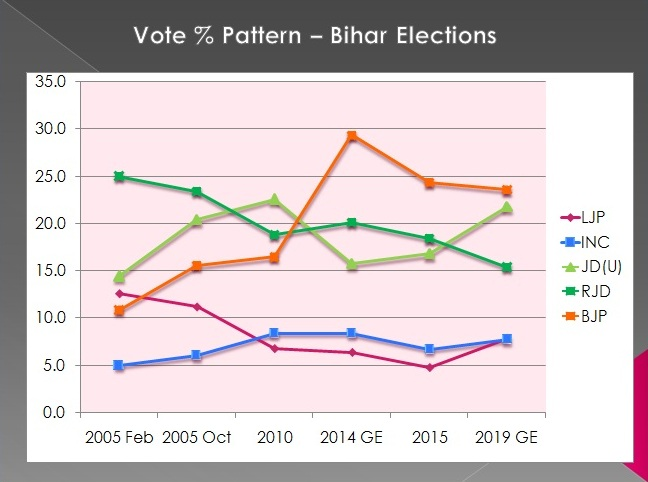Understanding BIHAR’s upcoming assembly elections
- In Politics
- 08:32 PM, Oct 25, 2020
- Shwetank Bhushan
The battle for Bihar is heating up. Nitish Kumar, the sitting Chief Minister, is seeking reelection on claims of his work in the last fifteen years. The question here is, is Bihar with him, or are they not?
The NDA Position:
With the absence of both Lalu Prasad Yadav and Ram Vilas Paswan from the scene, the 2020 Bihar election was supposed to be an all-Nitish affair. However, a lot has changed over the years. The problem of Nitish doubles because he is in power for a long.
Fifteen years in power is a long time, and it leaves leaders toxic in the voters' eyes, and they want them to be out of power. Take the case of Sheila Dixit or Shivraj Singh Chowhan, how voters voted them out despite their outstanding development work.
Nitish’s popularity graph is plummeting, mainly due to his flip flops - from BJP to RJD and back. And if that was not enough, he has earned the migrant workers ire for failing to bring them back during the initial lockdown. The State has also expressed anger against the Chief Minister for the poor handling of the COVID pandemic. This time it is not anti-incumbency but the anti-Nitish feeling on the ground. The only saving grace in his favor is the TINA (there is no alternative) factor that still allows him to be the preferred CM candidate.
It is important to note that the BJP has got an equal share in the Bihar state polls for the first time. From its share of 122, JDU gave seven seats to Jitan Ram Manjhi’s HAM, while the BJP allocated 11 seats to Mukesh Sahni's VIP from its share of 12 seats. It leaves JDU contesting on 115 seats and BJP on 110 — a very different picture from that of 2010 elections when JDU contested on 141 and BJP on 102 seats. The seat-sharing formula signals a significant climb-down by Nitish, recognizing it is a battle of survival.
Both urban and rural Bihar people agree that the power supply and roads have been better today, but they also feel it is not enough. Earlier, initiatives like 'cycle for girls,' 'Jeevika,' and 'Sharab-Bandi' were popular among women; however, they are losing shine. The liquor bottles are readily available in every corner in Bihar abundance at a much higher price. That the bootleggers have made a fortune at the State exchequer's cost is getting much traction.
It has caused a dent in the caste-neutral constituency of women voters that Nitish had created over the years. Nitish's body language shows that he knows that the ground support isn't enough for him to return to power.
Since 2005, the vote transfer between the traditional partners (JDU & BJP) has been smooth. BJP indeed desires to fulfill its dream of it's CM in Bihar. But it's also true that Nitish still enjoys 12-14% devoted vote share despite his declining popularity. Besides, BJP's State unit is a clueless, faceless, leaderless bunch of confused parrots that banks primarily on PM Modi’s popularity. Have you ever witnessed a prospective chief minister posting newspaper cuttings all day long on Twitter? That is the reason why BJP received a shocking defeat in 2015. Despite Bihar being mostly ready to embrace BJP as its next ruling party, it has refrained from going solo.
The overwhelming anger and the powerful anti-incumbency against the sitting CM were enough to defeat the ruling alliance. However, PM Modi has an exciting approval rating in Bihar, and with his popularity, BJP has been able to penetrate various sections cutting across the caste lines. The Modi-Govt's various flagship schemes have touched the lives of the State's poor and vulnerable section. Be it rural housing, toilets, refilling of cylinders under Ujjwala, or the account being credited with PM Kisan installment, the enrichment and dignity brought into the poor's life, irrespective of their castes, is quite evident. The double engine pushes the ruling alliance in a better position this election despite acute anti-incumbency.
However, despite having an initial edge, the BJP may suffer because this election is happening during a raging pandemic. Many of the elderly and vulnerable people may avoid going to polling booths for apparent reasons. Upper caste voters, particularly women, are also less likely to queue up at the polling station to cast their votes. On the other hand, in rural Bihar belonging to OBCs, Dalits, and Minorities, both men and women could turn out in strength. Low polling could be bad news for BJP.
Important to note here that BJP’s strike rate has always been higher than that of JD(U) except in 2015 when it was part of the Mahagatbandhan with the core of the Yadav-Koeri-Muslim combination. One thing is sure that BJP will get more seats than JDU, and post this election, it will replace JDU as the leader of one pole, while RJD will continue to play the lead role of the other pole. It will impact Nitish's political future even if he retains the Chief Minister’s post for a while.
Mahagathbandhan Position:
The Congress is part of the Mahagathbandhan in Bihar, including the Rashtriya Janata Dal and the Left parties. The Mahagathbandhan has already announced that Tejashwi Yadav will be its chief ministerial candidate. RJD being the leading party in the State, has got the lion's share of 144 seats. Congress will contest on 70 seats while the Left parties will contest on 29 seats among them.
Of these 70 seats, the Congress has not won 45 in the last two decades. However, in the absence of Lalu Yadav, RJD is likely to be a significant loser compared to being the single largest party in 2015 with 80 seats. This, mainly because Tejasvi lacks his father's charisma, who is absent from the election scene serving out a jail term in Ranchi.
The opposition is banking primarily on strong anti-incumbency. Lakhs of migrant workers, mostly youth, had to return to Bihar from other states during this pandemic. How they were received, quarantined, and rehabilitated remains an immediate consideration for them. In the absence of "Mahangayi and Bhrashtachar," the opposition hopes that these laborers' economic hardships will determine their voting preference ignoring the caste matrix. To what extent the 10 lakh jobs promise swings, the hopeless Bihari youth towards Mahagathbandhan remains to be seen.
Chirag Paswan - The X-Factor
Amidst all this, the walking out of the Lok Janshakti Party led by Chirag Paswan from State NDA, protesting against Nitish’s leadership, has emerged as a surprise. Chirag declared LJP would put up candidates against JDU but won’t contest against those of BJP. Some analysts say that Chirag has the tacit support of the BJP top leadership. This speculation about BJP’s game plan to deny Nitish the top post after the election has unnerved Nitish Kumar. However, the truth is that LJP has never contested any election in Nitish's alliance except the 2019 General Election.
As far as LJP is concerned, Chirag aims to utilize both Nitish’s declining popularity and cash in on Tejashwi Yadav’s failure to fill in the gap.
Ram Vilas Paswan’s political philosophy defines him as the Dalit leader and a kingmaker who outlasted many kings in his illustrious political career. At times, critics mocked him as "Mausam-Vaigyanik" to forge an alliance that would come to power after elections. This time too, the decision to go solo has been taken in consultation with senior Paswan. Chirag will indeed miss out on his charismatic father's experience. Still, Ram Vilas Paswan’s death may also spark a wave of sympathy for his scion.
Chirag Paswan has criticized Nitish Kumar over various issues, including the latter's "failure" to usher development as promised and handling the Covid-19 pandemic. By consolidating the party’s core voter base, Chirag may damage JDU candidates in constituencies where Dalits have a sizeable presence. Also, by asserting himself as Narendra Modi's "Hanuman," Chirag has very smartly made it clear that he is willing to go with BJP post-election and attracting BJP's core voters saddened with Nitish. With this strategy, it will dent the JDU and eat into the anti-BJP votes that may go to Mahagathbandhan, to the advantage of BJP.
The Number Logic:
One cannot understand the Bihar election without understanding the importance of the caste matrix and numbers' logic.

Lalu Yadav’s “MY” (17% Muslim + 14% Yadav) combination is intact. However, some of the Yadav votes have drifted to the BJP with its commitment to power. Muslims will vote solidly against the BJP-led NDA alliance except for some of the Pasmandas who support Nitish Kumar. The Congress brings nothing much except a section of upper caste and some old loyalty and helps consolidate the Muslim votes.
The BJP has loyal support among the upper castes (17%), Banias (7%), and urban voters, while the JDU has successfully cultivated an alliance of the Mahadalits (10%), and non-Yadav other backward classes (OBCs) - the Kurmis (4%) and Koeris (5%). Besides, the HAM and VIP also bring a fair amount of Mahadalit, OBC to the kitty.
Ram Vilas Paswan’s LJP has many loyal small sub-castes from OBCs and Dalits (6%) under its umbrella.
However, it is the 20% Extremely Backward Community (EBC), who do not have a clear leader and have traditionally voted for the NDA, should seal the outcome of the Battle for Bihar.
Apart from the number logic, smart ticket distribution always remains one of the most crucial factors in an alliance-changing, caste-centric election battle and flares a lot of local resentment.
Conclusion:
Although the arithmetic favors NDA at this point, it won't be a walk in the park for either alliance. In all probability, the result of the ensuing assembly election is heading towards a crucial post-result exercise.
Image Credit: ANI
Disclaimer: The opinions expressed within this article are the personal opinions of the author. MyIndMakers is not responsible for the accuracy, completeness, suitability, or validity of any information on this article. All information is provided on an as-is basis. The information, facts or opinions appearing in the article do not reflect the views of MyindMakers and it does not assume any responsibility or liability for the same.







Comments